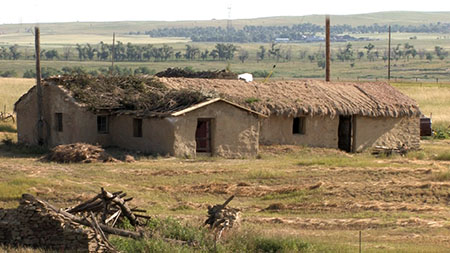The House

The Hutmacher's Home
The Hutmacher home consists of five rooms: Two bedrooms, a living room, kitchen and foyer/pantry.
The house was built in stages between 1928 and 1962.
The exterior stone walls are about two feet thick. The thermal mass of the stones in the wall served to keep the house cool in the summer and warm in the winter.
There were no windows or doors on the north side of the house.
The two central rooms were built first and served as bedroom/living and dining/kitchen. The original entry door was located in the south-facing wall of the original bedroom. A mud/straw plaster was used to finish the interior walls and were painted bright colors.
The two rooms are separated by a wattle-and-daub wall of interwoven branches covered with a mud/straw plaster. The wattle-and-daub wall separated the rooms without taking up too much of the limited interior space.
The original floor was bare ground, but a wood floor was later installed using lumber salvaged from the nearby Valentine Hutmacher house after Valentine passed away and his house was abandoned.
The interior ceiling was finished by covering the rafters with cardboard and oil cloth. The cardboard was installed using old Mason jar lids as washers. The cardboard was covered with oil cloth which was incorporated into the plaster on the walls and then painted.
The kitchen was added to the west shortly after the original house was built. The walls were covered in oilcloth and painted. This technique prevented the mud plaster from flaking off in the cooking area and provided a scrubbable surface.
Kitchen storage was fashioned by using wooden shipping crates under the chimney for the coal stove. A rack on the wall held cooking utensils. An empty thread spool was mounted the door and was used to hang the dishcloth.
A second bedroom was added on the east side in 1950. When the Hutmachers’ daughter Emma married Frank Urlacher, her parents turned this bedroom over to the new couple for a time to serve as a honeymoon suite.
Frank Hutmacher’s wife, Veronica, received a small inheritance in the early 1960s, and she wanted a freezer. To make space for the freezer, a pantry off the kitchen was added in 1962. Electricity was run to the farm at the same time and the sons-in-law helped wire the house for lights and outlets.
The House

